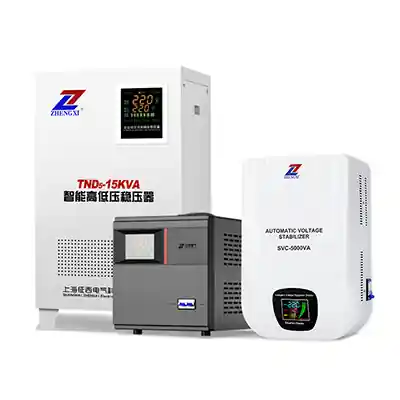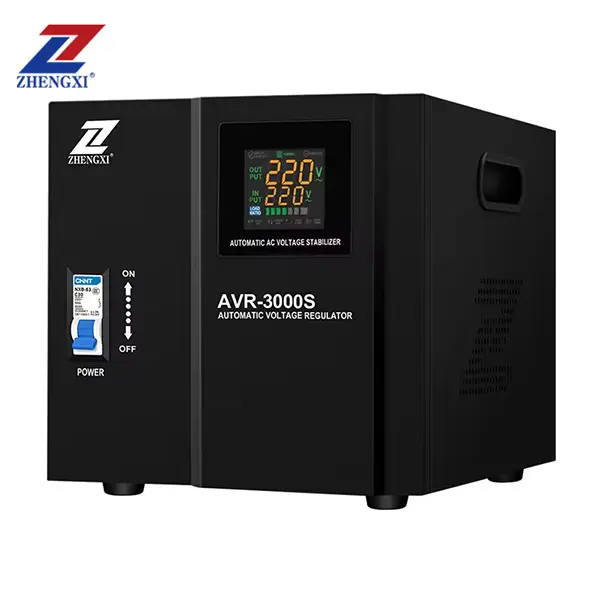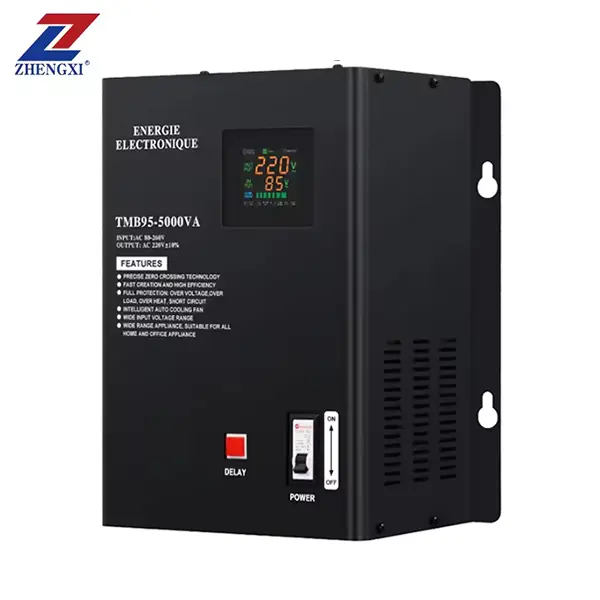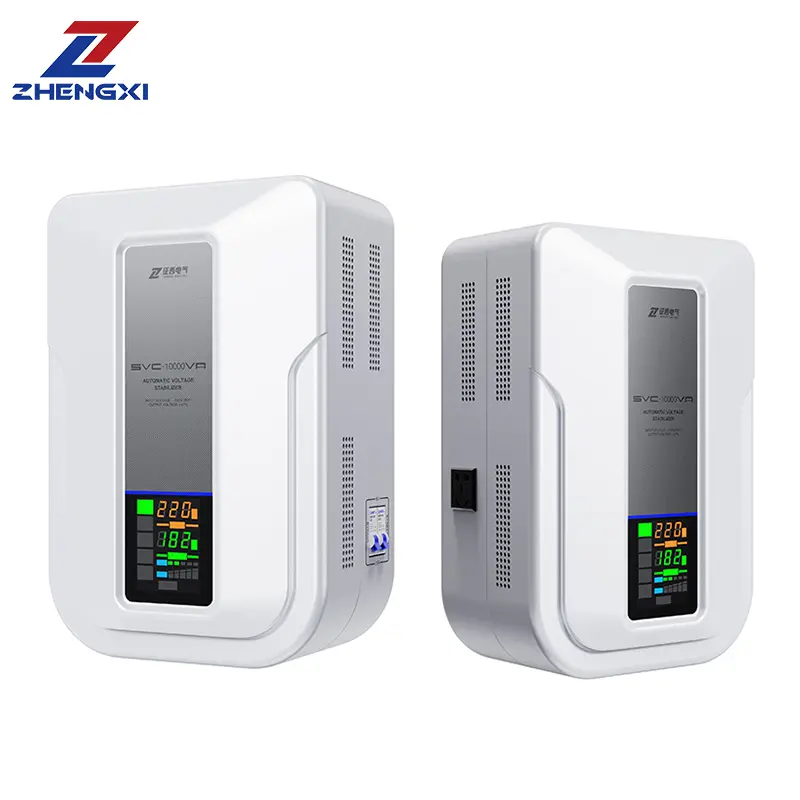1. Introduzione: Perché la stabilità della tensione è importante
Sia che si tratti di un piccolo appartamento o di una fabbrica ad alta intensità di lavoro, le fluttuazioni di tensione possono creare scompiglio: danneggiare i compressori dei condizionatori d'aria, bruciare i microchip dei computer o bloccare le linee di produzione. Un stabilizzatore elettrico, chiamato anche un regolatore automatico di tensione (AVR)Il sistema di controllo della tensione, che agisce come un guardiano, assicura che i vostri dispositivi vedano sempre il "punto dolce" di tensione di cui hanno bisogno.
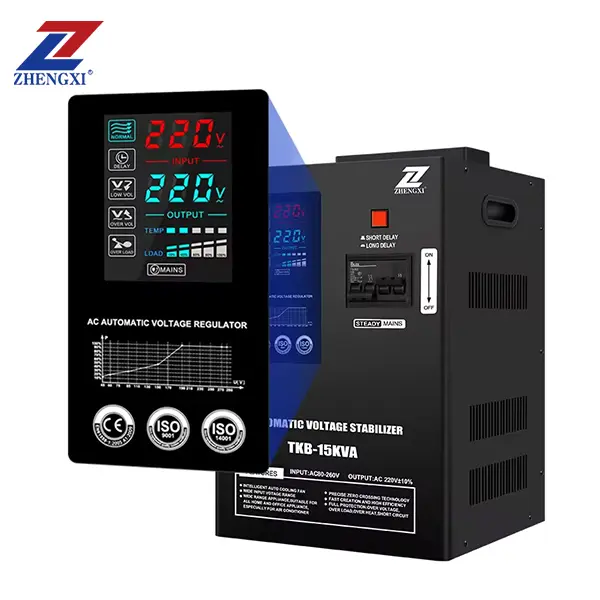
2. Stabilizzatore elettrico vs. convertitore di tensione: differenze chiave
Molti utenti confondono gli stabilizzatori con i convertitori step-up/step-down. Ecco come si differenziano:
| Caratteristica | Stabilizzatore (AVR) | Convertitore (trasformatore) |
|---|---|---|
| Scopo | Mantenimento della tensione di uscita costante | Modifica del livello di tensione su/giù |
| Risposta | Millisecondi (tipo servo/statico) | Rapporto istantaneo ma fisso |
| Applicazione | Protezione contro le fluttuazioni | Adattamento della tensione a diverse reti elettriche |
| Uso comune | Elettrodomestici, carichi industriali | Apparecchiature da viaggio, attrezzature tradizionali |
3. Come funziona uno stabilizzatore elettrico
- Rilevamento della tensione: Misura continuamente la rete elettrica in ingresso.
- Rilevamento degli errori: Confronta la tensione rilevata con un intervallo "nominale" preimpostato (ad esempio, 220 V ±10%).
- Meccanismo di correzione:
- Tipo di servoassistenza: Un motore regola i taps del trasformatore per ottenere un'uscita precisa.
- Tipo statico: Gli interruttori a semiconduttore ad alta velocità aumentano o riducono la tensione.
Anche un ritardo di 10 ms può fare la differenza tra un funzionamento sicuro e una scheda di circuito bruciata.
4. Tipi di stabilizzatori elettrici
Stabilizzatori a relè
- Come funziona: I relè meccanici commutano i rubinetti.
- Ideale per: Piccoli elettrodomestici (TV, piccoli frigoriferi).
- Pro/Contro: Risposta conveniente ma più lenta (~100 ms).
Stabilizzatori servocontrollati (motorizzati)
- Come funziona: Il motore CC sposta gli avvolgimenti del trasformatore.
- Ideale per: Attrezzature di precisione (macchine CNC, strumenti di laboratorio).
- Pro/Contro: Alta precisione (±1%), ma ingombro maggiore.
Stabilizzatori statici (a stato solido)
- Come funziona: Commutazione basata su IGBT o TRIAC.
- Ideale per: Uffici, home theater, server di rete.
- Pro/Contro: Ultraveloce (<20 ms), compatto; costo per kVA leggermente superiore.
Servo stabilizzatori digitali
- Come funziona: Il microprocessore controlla il servomotore.
- Ideale per: Applicazioni critiche che richiedono monitoraggio e registrazione.
- Pro/Contro: Display digitale, comunicazione a distanza; prezzo premium.

5. Caratteristiche e specifiche critiche da confrontare
- Capacità (kVA): Corrisponde al carico totale dell'apparecchio + buffer 20%.
- Intervallo di tensione in ingresso: Gamme più ampie (ad esempio, 100-300 V) gestiscono griglie instabili.
- Tempo di risposta: La correzione più rapida riduce le sollecitazioni sull'elettronica.
- Efficienza / Perdita di potenza: Cercare perdite in standby ≤3%.
- Visualizzazione e avvisi: Lettori LED/LCD, allarmi di mancanza di fase e di sovraccarico.
- Protezioni di sicurezza: Sovraccarico, cortocircuito, sovratensione, inversione di fase.
- Certificazioni: IEC, CE, RoHS, ISO9001 garantiscono qualità e conformità.
6. Migliori pratiche di installazione e manutenzione
- Selezione del sito: Area fresca, ventilata, priva di polvere e lontana dalla luce solare diretta.
- Cablaggio: Utilizzare cavi di dimensioni adeguate; fissare tutti i collegamenti secondo le norme elettriche locali.
- Messa a terra: Una messa a terra adeguata riduce al minimo i disturbi e protegge dai fulmini.
- Controlli periodici (ogni 6-12 mesi):
- Ispezionare la presenza di polvere e detriti.
- Verificare il serraggio delle viti dei terminali.
- Testare la risposta simulando condizioni di bassa/alta tensione.
7. Caso di studio del mondo reale: Protezione di un'officina CNC
Sfida: I frequenti cali di tensione portavano all'arresto della fresa CNC, con un costo di 2 ore al giorno di fermo macchina.
Soluzione: Installato un servo stabilizzatore digitale da 45 kVA con precisione di ±1% e monitoraggio in tempo reale.
Risultato: Zero arresti non programmati in 6 mesi; ROI raggiunto in meno di 4 mesi grazie all'aumento della produttività.
8. Applicazioni e casi d'uso principali
- Casa e residenziale: Frigoriferi, forni a microonde, smart TV.
- Ufficio e commerciale: Computer, server, apparecchiature mediche.
- Industriale: Saldatrici, compressori, sistemi di taglio laser.
- Specialità: Torri di telecomunicazione, inverter per energie rinnovabili, analizzatori di laboratorio.
9. Risoluzione dei problemi comuni
| Sintomo | Possibile causa | Azione raccomandata |
|---|---|---|
| Nessuna uscita nonostante la potenza in ingresso | Fusibile interno bruciato | Sostituire il fusibile, controllare il sovraccarico |
| La tensione di uscita varia lentamente | Contatti del servo sporchi/sciolti | Pulire i contatti, ricalibrare |
| Allarme di sovraccarico costantemente attivo | Carico > capacità dello stabilizzatore | Riduzione del carico o ridimensionamento dell'unità |
| Scatti frequenti del relè (tipo relè) | Oscillazioni rapide della tensione | Aggiungere la funzione di ritardo o passare al tipo statico |
10. DOMANDE FREQUENTI
Q1. A cosa serve uno stabilizzatore elettrico?
Uno stabilizzatore elettrico assicura che i dispositivi sensibili ricevano una tensione costante, proteggendo da eventi di sottotensione e sovratensione.
Q2. Posso usare uno stabilizzatore per il mio condizionatore d'aria?
Sì: scegliere uno stabilizzatore con un valore nominale di 20-30% superiore alla potenza in kVA della corrente alternata per gestire le sovratensioni all'avvio.
Q3. Come si dimensiona uno stabilizzatore per più apparecchi?
Sommare la potenza totale (o VA) di tutti i dispositivi collegati, quindi aggiungere un margine di sicurezza di 20% quando si seleziona la capacità kVA.
Q4. Qual è la differenza tra stabilizzatori monofase e trifase?
Le unità monofase (220-240 V) sono adatte alle abitazioni e ai piccoli uffici; le unità trifase (380-415 V) sono progettate per i macchinari industriali.
Q5. Gli stabilizzatori consumano molta energia?
I moderni stabilizzatori presentano basse perdite in standby (in genere 1-3%), per cui il consumo di energia operativa è minimo.
Q6. Con quale frequenza devo sottoporre a manutenzione il mio stabilizzatore?
La regola generale è ogni 6-12 mesi: ispezionare il cablaggio, pulire la polvere e verificare la calibrazione.
Q7. Gli stabilizzatori digitali sono migliori di quelli analogici?
Gli stabilizzatori digitali offrono un controllo preciso, la registrazione dei dati e il monitoraggio remoto, che possono essere preziosi per le applicazioni mission-critical.
Q8. Gli stabilizzatori possono proteggere dai fulmini?
Sebbene gli stabilizzatori includano una protezione contro le sovratensioni, per una difesa completa è bene prendere in considerazione gli scaricatori di sovratensioni dedicati o quelli per l'intero edificio.
Siete pronti a salvaguardare le vostre apparecchiature con una regolazione della tensione leader del settore?
Esplorate l'intera gamma di stabilizzatori monofase, trifase, servo e statici di SUNWAY, supportati dalle certificazioni ISO9001, CE e RoHS, oltre al supporto OEM/ODM in tutto il mondo.

